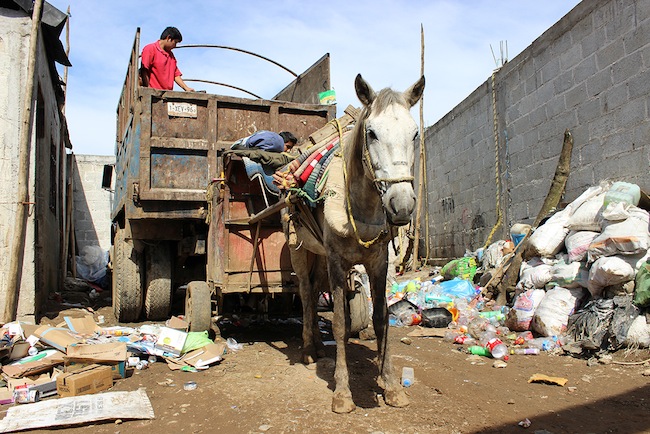New Open-Access Research Paper Collection Will Help Welfare of Working Equids
- March 10, 2017
- ⎯ Fran Jurga

A new collection of open-access research articles aims to build greater understanding and encourage collaboration in addressing the welfare problems of the world’s working equids. Published online this month by the Equine Veterinary Journal (EVJ), the collection is sponsored by World Horse Welfare, and is based on research presented at the charity’s 7th International Colloquium on Working Equids in July 2014. More research articles will be added to the collection as new data emerges.
In July this year more than 150 representatives from 27 countries attended World Horse Welfare’s 7th International Colloquium on Working Equids to discuss the plight of the estimated 100 million working “equids”–horses, donkeys and mules–who sustain human livelihoods around the world.
A key outcome of the event was the recommendation that broader access to research would encourage greater worldwide collaboration. In prompt response, the EVJ has published a compendium of eight diverse research papers, with support from World Horse Welfare. Plans are for the collection to grow annually to form an exclusive free resource for all practitioners working in equine welfare.
The current collection addresses clinical problems such as lameness, husbandry, tack-related wounds, gastric lesions in donkeys, parasite infestation, and the risks associated with the meat and milk of the working equid in the human diet. It also includes a summary paper from the 2014 Colloquium on Working Equids.
Roly Owers, Chief Executive of World Horse Welfare explained: “To improve the effectiveness of programs focused on working equids globally, we need to share information globally. Research builds the evidence base for better interventions and helps improve collaboration between equine charities and veterinary organizations, with human development organizations, universities and governments. Wider access to relevant research should make an even greater, sustainable impact for working equids and World Horse Welfare is pleased to support the EVJ in helping to achieve this end.”
Scientific research often has direct practical applications that can be of immediate benefit to working equids. Through World Horse Welfare’s recent work, owners in Central America now know that the severe hoof separation and mouth lesions in working horses are not caused by a local species of spider biting or urinating on the area. Similarly horse owners in Honduras are learning that the lesions near their horses’ eyes are not caused by flies, but could be the result of inappropriate whip use, with the injuries then exacerbated by flies.
Professor Celia Marr, editor of the Equine Veterinary Journal said: “British-based equine welfare charities are leading in the efforts to help working equids overseas, so it is only natural for the Equine Veterinary Journal to take a lead in disseminating pertinent research work. We are proud to make this important contribution and look forward to building the collection of articles into a substantial reference library.”
All articles relevant to working equids are free online at http://onlinelibrary.wiley.com/journal/10.1001/%28ISSN%292042-3306/homepage/working_equid_virtual_issue.htm.
The current table of contents:
World Horse Welfare online collection of research on working equids R. Owers and C. Marr
The contribution of donkeys to human health M. Ali, M. Baber, T. Hussain, F. Awan and A. Nadeem
Science in brief: Report from the Seventh International Colloquium on Working Equids, London 2014 P. Compston
The range and prevalence of pathological abnormalities associated with lameness in working horses from developing countries C. E. Broster, C. C. Burn, A. R. S. Barr and H. R. Whay
Pack wounds of donkeys and mules in the Northern High Atlas and lowlands of Morocco P. D. Sells, G. Pinchbeck, H. Mezzane, J. Ibourki and M. Crane
Cross-sectional survey of owner knowledge and husbandry practices, tack and health issues affecting working horses in Lesotho M. M. Upjohn, K. Shipton, D. U. Pfeiffer, T. Lerotholi, G. Attwood and K. L. P. Verheyen
The range and prevalence of clinical signs and conformation associated with lameness in working draught donkeys in Pakistan C. E. Reix, C. C. Burn (nèe Broster), J. C. Pritchard, A. R. S. Barr and H. R. Whay
Pathology of gastric lesions in donkeys: A preliminary study A. K. Al-Mokaddem, K. A. Ahmed and R. E. Doghaim
Characterisation of nasal Staphylococcus delphini and Staphylococcus pseudintermedius isolates from healthy donkeys in Tunisia H. Gharsa, K. Ben Slama, E. Gómez-Sanz, P. Gómez, N. Klibi, M. Zarazaga, A. Boudabous and C. Torres
Identifying differences in working donkeys in response to analgesic administration F. H. Regan, J. Hockenhull, J. C. Pritchard, A. E. Waterman-Pearson and H. R. Whay
New papers will be added regularly. More research is desperately needed on working equids and World Horse Welfare offers bursaries to veterinary students and research grants to encourage research into of major welfare challenges both in the UK and overseas.
To find out more contact [email protected].





